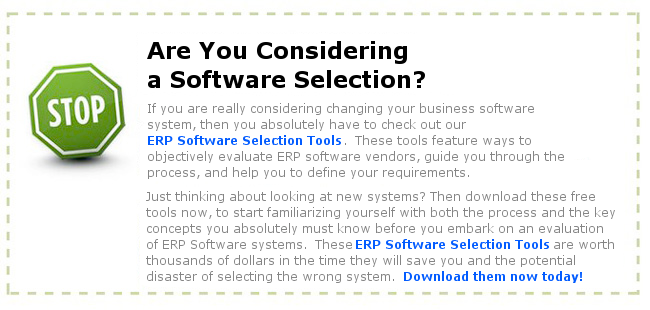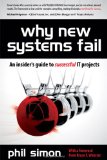[ReviewAZON asin=”B00166SO00″ display=”fullpost”]
Tag: Erp Applications
ERP and Cloud Applications Strategies
There is an informative article on ERP and Cloud Applications Strategies at SoftwareAdvice.com. In the article, the author discusses the considerations of implementing the Suite of an ERP solution or doing a Best-of-Breed approach where a company would pick and choose the functionality from various vendors. Not so long ago, companies would only pick a suite and stay within its boundaries.
Now, however, companies are finding that moving to a varied vendor set, including a mix of traditional and cloud applications provides some advantages. This brings up some questions: How well does this work? What are some of the considerations you need to look at before making an investment in a cloud app? Let’s take a look at these issues.
Cloud Applications as a Best-of-Breed Approach
The typical scenario for many companies is one of adding a cloud CRM such as Salesforce.com, to their mix of in-house ERP applications. More often than not, Salesforce is acquired by the business users and IT does not even know of its existence until the business users ask for integrations to the back-end systems.
One concern for moving to Cloud Applications is that frequently, IT departments do not “get” cloud computing. In fact, they often see it as a threat. Because the applications are hosted elsewhere, there is little or no overhead required from an IT department. The IT department does need to be involved in Cloud Application selections and implementations so that they understand what will be implemented.
 Secondly, modern Cloud Applications such as Salesforce.com do not require traditional programming overhead.
Secondly, modern Cloud Applications such as Salesforce.com do not require traditional programming overhead.
Because it is configuration based, adding a field is as simple as filling out a form. If you find you don’t want that field, remove it. In traditional applications management, you would want to run this field addition in a sandbox, test it thoroughly to make sure it doesn’t break anything. In a cloud application, like Salesforce.com, you simply don’t expose the field to the users until you review it. You do not need to implement a sandbox to change configurable settings.
As pointed out above, IT departments frequently do not get this paradigm. They are used to code-upon-code where small changes make a big deal. In a configuration environment of a cloud application, there is little if any impact when configuration changes occur. Everything lives as metadata. Nothing touches the code.
Because many of the available cloud offerings are configuration driven, they are much faster to get up and running. Due to this, it often make sense to run an agile-like implementation of various releases (or sprints) of various best of breed applications coming on-line at different times. Not everyone chooses to do this, but a two or three-month release cycle of various solutions provides a way to move forward on systems quickly.
Integrating Cloud Applications with non-Cloud Applications
After configuration, integrations need to be defined and typically there are three options. First, you can manually export a csv file from the source system and upload it to the target system. This works for very basic updates. The next option is custom coding to push/pull the data from the APIs (Application Programming Interfaces). The last option is to use a Middleware product such as Pervasive, Informatica, or Boomi.
Traditionally, middleware was a separate application sitting on an on-premise server and it would transact the data between the source and target systems. It would also perform and data transformations that needed to occur to align the fields between the systems.
Now, there is a trend to going to Cloud-based middleware, such as with Informatica-on-demand. Like other cloud solutions, they come with a less expensive price tag and they do not require a full implementation on an on-premise server. Rather, what they do need is a small install of an “Agent” software that allows the cloud app to talk to the in-house solutions.
These middleware cloud applications work well, but they do have some limitations. First, since they are newer than the traditional software, they still have some bugs. Not a lot, but don’t be surprised if you run into one. Next, they have a more limited toolset than the traditional in-house solutions as the programming and scripting tools are not as robust (but they are getting better every day).
Moving forward with Cloud Applications
Using Cloud Applications has many benefits, including financial and technical reasons for approaching the platform. Often Cloud Apps can be charged as an expense monthly rather than being capitalized like large asset purchases. Further, you can buy as much or as little licensing as you need and scale up or down much more readily than a traditional application.
All-in-all, Cloud applications have tremendous benefits to organizations as part of a best-of-bread solution. For a smaller firm, an app like Netsuite may provide a complete solution, but for the larger enterprise, a “pick and choose” solution strategy may be a good way to go.
Best Practices in ERP Software Applications: Accounting, Supply Chain Planning, Procurement, Inventory
Product Description
The purpose of Best Practices in ERP Software Applications is to disseminate knowledge about the state-of-the-art in ERP (Enterprise Resource Planning) systems and the business best practices embedded in the systems.It is written for business professionals, project managers, consultants, team leaders, programmers, technicians, vendors, service providers, executives, teachers and students who are working, managing or studying in the field of software application deve… More >>
Best Practices in ERP Software Applications: Accounting, Supply Chain Planning, Procurement, Inventory

Causes of ERP Failures
Here is an article that zooms right into the reasons for why ERP implementations fail:
Causes of ERP Failures
by: Bruce Zhang
ERP is the acronym of Enterprise Resource Planning. Multi-module ERP software integrates business activities across various functional departments, from product planning, parts purchasing, inventory control, product distribution, to order tracking. ERP has transformed the way multi-billion dollar corporations conduct their businesses. Successful implementation of ERP systems could save tens of millions of dollars and increase employee satisfactions, customer satisfactions and sustain competitive advantages in every-changing marketplace. Corporate executives are often perplexed by the stories that how reputable corporations (Hershey Foods) have failed miserably and lost ten of millions of dollars in their ERP endures.
The failures of ERP projects are preventable if we can identify the common causes of the failures regardless the companies and industries that implement them.
An ERP system is the combination of ERP software, the business processes that the ERP transforms, the users of the ERP system, and the computer systems that run the ERP applications. The failures of a ERP project is often the result of the failures in one or more of those four components. The failures in computer systems (hardware and operating systems) are much easier to identify and to fix, so we’ll examine the failures in software implementation, business process and user acceptance.
Failure of ERP Software Implementation
Module-based ERP software is the core of ERP systems. Most ERP projects involve significant amount of customizations. Packaged ERP software modules have built-in functionality that work in a standard and simplified enterprise environment. However, every organization is unique in data requirements and business processes. It is the customizations that transform packaged ERP software into ERP software that meets organizations’ individual business processes and operations. Long and expensive customization efforts often result the pass of release deadline and budget overrun. Customizations may make the software more fragile and harder to maintain when it finally goes to production. Major changes may be required in the later stage of the implementation as a result of incomplete requirements and power struggles within organizations
 |
Why New Systems Fail: An Insider’s Guide to Successful IT Projects |
The integration of ERP systems (http://www.sysoptima.com/erp/erp_integration.php) with the IT infrastructures also challenges ERP project teams. The use of appropriate implementation methodologies can often make or break a ERP project. (http://www.sysoptima.com/erp/implementation_methodologies.php)
Failure of Accommodating Evolution of Business Processes
According to Anthony, R. A, business processes fall into three levels – strategic planning, management control and operational control. Organizations continuously realign their business processes of all levels in response to the ever-changing market environment. Many ERP systems aren’t flexible enough to accommodate evolution of business processes. many ERP system need a major overhaul in every a couple of years.
Failure of User Acceptance
The users of ERP systems are employees of the organizations at all levels. ERP projects usually modify the company’s business processes which create extra workload for employees who use them initially. They may not think that the workflow embedded in the software are better than the ones they currently use. Ongoing end-user involvement and training may ease the difficult in organization’s adaptation of new systems and new business processes.
About The Author
Bruce Zhang has over 10 years experiences in developing and implementing ecommerce and ebusiness systems in various industries.
He operates a website http://www.sysoptima.com that automatically aggregates the news and new articles in e-business (ERP, CRM,
Supply Chain Management and Knowledge Management) from over 50 sources daily (http://www.sysoptima.com/newsbot/) to help corporate executives, professionals and consultants to keep up with the latest development in enterprise software market. The website offers a knowledge base for understanding business software from a systems perspective.
Causes of ERP Failures
Causes of ERP Failures
by Bruce Zhang
ERP is the acronym of Enterprise Resource Planning. Multi-module ERP software integrates business activities across various functional departments, from product planning, parts purchasing, inventory control, product distribution, to order tracking. ERP has transformed the way multi-billion dollar corporations conduct their businesses. Successful implementation of ERP systems could save tens of millions of dollars and increase employee satisfactions, customer satisfactions and sustain competitive advantages in every-changing marketplace. Corporate executives are often perplexed by the stories that how reputable corporations (Hershey Foods) have failed miserably and lost ten of millions of dollars in their ERP endures.
The failures of ERP projects are preventable if we can identify the common causes of the failures regardless the companies and industries that implement them.

- Image by Behrooz Nobakht via Flickr
An ERP system is the combination of ERP software, the business processes that the ERP transforms, the users of the ERP system, and the computer systems that run the ERP applications. The failures of a ERP project is often the result of the failures in one or more of those four components. The failures in computer systems (hardware and operating systems) are much easier to identify and to fix, so we’ll examine the failures in software implementation, business process and user acceptance.
ERP Failures -Software Implementation
Module-based ERP software is the core of ERP systems. Most ERP projects involve significant amount of customizations. Packaged ERP software modules have built-in functionality that work in a standard and simplified enterprise environment. However, every organization is unique in data requirements and business processes. It is the customizations that transform packaged ERP software into ERP software that meets organizations’ individual business processes and operations. Long and expensive customization efforts often result the pass of release deadline and budget overrun. Customizations may make the software more fragile and harder to maintain when it finally goes to production. Major changes may be required in the later stage of the implementation as a result of incomplete requirements and power struggles within organizations
The integration of ERP systems (http://www.sysoptima.com/erp/erp_integration.php) with the IT infrastructures also challenges ERP project teams. The use of appropriate implementation methodologies can often make or break a ERP project. (http://www.sysoptima.com/erp/implementation_methodologies.php)
ERP Failures – Failure of Accommodating Evolution of Business Processes
According to Anthony, R. A, business processes fall into three levels – strategic planning, management control and operational control. Organizations continuously realign their business processes of all levels in response to the ever-changing market environment. Many ERP systems aren’t flexible enough to accommodate evolution of business processes. Many ERP system need a major overhaul in every a couple of years.
ERP Failures – Failure of User Acceptance
The users of ERP systems are employees of the organizations at all levels. ERP projects usually modify the company’s business processes which create extra workload for employees who use them initially. They may not think that the workflow embedded in the software are better than the ones they currently use. Ongoing end-user involvement and training may ease the difficult in organization’s adaptation of new systems and new business processes.
Bruce Zhang has over 10 years experiences in developing and implementing ecommerce and ebusiness systems in various industries. He operates a website www.sysoptima.com that automatically aggregates the news and new articles in e-business (ERP, CRM, Supply Chain Management and Knowledge Management) from over 50 sources daily (www.sysoptima.com/newsbot/) to help corporate executives, professionals and consultants to keep up with the latest development in enterprise software market. The website offers a knowledge base for understanding business software from a systems perspective.
Another Related ERP Failures post
Causes of ERP Failures


